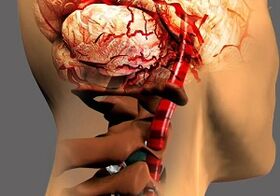Pathological conditions of the musculoskeletal system are more common than other known diseases. According to statistics, after the age of 40, everyone experiences symptoms of similar diseases. Symptoms of cervical osteochondrosis are especially common. Therefore, the symptoms and treatment of cervical osteochondrosis, as well as its causes, should be known to everyone in order to prevent the disease and prevent complications.

What is cervical osteochondrosis?
Osteochondrosis is a disease characterized by changes in the intervertebral discs and dystrophy of cartilage tissue. Osteochondrosis of the cervical spine occurs in 25% of cases and develops due to the structural features of the spine.
The cervical region consists of 7 vertebrae of different structures located very close to each other. Complex movements are performed in this part of the body. There are many peripheral and spinal nerves in the cervical region that affect the internal organs. In addition, the neck is saturated with blood vessels, the main vessels pass through here: the jugular vein, carotid and vertebral arteries. Often, with pathology, the vertebral artery involved in the blood supply to the brain suffers.
Involvement of vessels and nerves in the process leads to the development of serious complications (cerebral ischemia, stroke), so timely detection of symptoms and treatment of cervical osteochondrosis are important issues in medicine and human health.
Causes and symptoms of the disease
The causes of cervical osteochondrosis are many, but all of them contribute to an increase in the load on the neck or a change in the structure of the spine itself. They are:
- posture disorder;
- excess weight;
- sedentary lifestyle;
- spinal cord injury;
- increased physical activity;
- stress;
- poor physical fitness;
- genetic predisposition;
- excessive muscle tension during work;
- hormonal diseases;
- metabolic changes;
- poor nutrition;
- cervical spine anomalies and defects;
- spinal diseases.
Clinical signs of pathology are associated with the structural features of the cervical segment of the spine. The smallest pathological processes cause such symptoms. Patients often complain:
- pain in the neck, back of the head, arms and shoulders, head;
- weakness of the hands and impaired sensitivity;
- limited mobility in the neck and upper extremities;
- crisis when turning and tilting the head;
- dizziness;
- lack of coordination;
- weakness;
- hearing, vision changes.
Osteochondrosis rates

The degree of pathology depends on the clinical manifestations and complaints.
- 1 degree. There are practically no symptoms. There is a slight pain and discomfort that increases with movement in the neck. A mild muscle overload associated with the development of compressed nerve and radicular syndrome is prescribed.
- 2nd degree. The patient is concerned about the severe pain in the neck that spreads to other parts of the body and occurs as a result of reduced distance between the vertebrae and compression of the nerves. There are also headaches, severe general weakness, and decreased performance. This is due to the addition of vertebral artery syndrome (involved in the pathological process).
- 3 degrees. The symptoms are strong, growing, the pain is persistent and unbearable. There is a violation of the sensitivity of the upper extremities, weakness, limited mobility of the cervical segment. This is due to the development of intervertebral hernias.
- 4 degrees. The intervertebral disc is completely replaced by connective tissue, which causes constant pain, stiffness, tinnitus, impaired vision, hearing and coordination. Persistent brain and movement disorders are characteristic.
Symptoms and photographs of cervical osteochondrosis show the severity of the pathology, so be sure to see a doctor when the first symptoms appear.
Treatment

The symptoms and treatment of cervical osteochondrosis are interrelated, as therapies reduce and eliminate symptoms. The disease can be completely cured only in the early stages, but few people seek help during this period. In other cases, therapy can stop further degenerative-dystrophic changes, reduce symptoms, and prevent the development of complications.
Many people wonder how to treat the symptoms of cervical osteochondrosis. There is no definitive answer, because each patient is an individual and treatment methods must be chosen for each specific situation. However, all the principles of therapy are reduced to reduce inflammation and pain, eliminate muscle spasms, improve cervical spine blood supply and nutrition, and strengthen the musculoskeletal system.
Basic treatment methods:
- take medicine;
- physiotherapy;
- massage;
- Sports therapy.
Medications:
- NSAIDs (relieves inflammation and pain);
- B vitamins (improves metabolism and nutrition of nerve fibers);
- muscle relaxant (to relieve muscle spasms);
- chondroprotectors (stop the destruction of cartilage tissue and help regenerate);
- warming creams and ointments (to relieve pain and muscle spasms).
You should not limit yourself to just taking medication. It is important to use all therapy methods comprehensively and systematically. The combination of medication, massage and exercise therapy helps to achieve fast results and helps to maintain the effect for a long time.



































